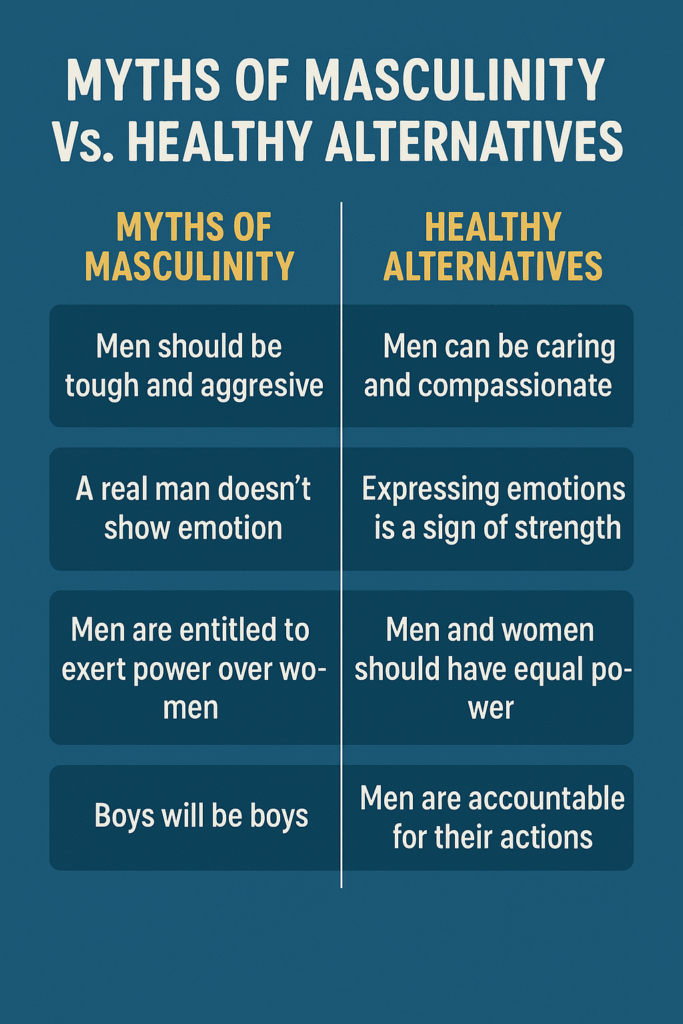Introduction
Violence against women remains one of the most pervasive and persistent human rights violations in the world. While interventions have traditionally focused on protecting and supporting survivors, an equally important approach has emerged: engaging men as allies, advocates, and agents of change. Ending violence against women is not a “women’s issue” — it’s a societal issue, and men must be involved in dismantling the patriarchal attitudes, behaviors, and systems that allow such violence to thrive.
This article explores why engaging men matters, how it works, the challenges involved, and real-world strategies to transform attitudes, reshape masculinity, and create safer, more respectful communities.

Caption: Men participating in a violence prevention workshop focused on empathy and accountability.
Why Men Must Be Part of the Solution
Men make up the vast majority of perpetrators of violence against women — particularly intimate partner violence, sexual assault, and harassment. This isn’t to say that all men are violent. But it is to recognize that violence against women is overwhelmingly driven by a culture of gender inequality, dominance, and entitlement — ideas that many men are taught, explicitly or implicitly, from a young age.
Engaging men is not about blaming them — it’s about inviting them to take responsibility for dismantling systems that harm others and themselves. It’s about teaching alternative models of masculinity rooted in respect, compassion, vulnerability, and equality.
When men are actively engaged:
- They challenge harmful stereotypes among peers.
- They model healthy, non-violent behaviors.
- They support victims and survivors.
- They help raise sons and daughters with healthier values.
The Roots of the Problem: Patriarchal Masculinity
Traditional patriarchal masculinity encourages men to be:
- Dominant, powerful, and emotionally detached.
- Aggressive or competitive in relationships.
- Disconnected from empathy, nurturing, and vulnerability.
These norms are often reinforced by media, religion, education, and peer pressure. When men feel that their masculinity is judged based on control, status, or emotional suppression, they’re more likely to:
- Use violence to assert dominance.
- Feel entitled to women’s attention, bodies, or submission.
- Struggle with emotional regulation and healthy communication.
Caption: Toxic masculine expectations are passed down unconsciously and socially reinforced.
How to Engage Men Effectively
Engaging men in anti-violence work requires more than just awareness campaigns. It demands emotional work, long-term commitment, and a deep challenge to identity and beliefs. Here are the key components:
1. Create Safe Entry Points
Many men may feel defensive or confused about the topic. It helps to:
- Start with empathy, not accusation.
- Frame the issue around relationships, fatherhood, and emotional health.
- Acknowledge that many men were never taught emotional tools and are themselves harmed by patriarchy.
2. Use Peer Education and Role Models
Men are often more open to change when the message comes from peers or respected figures. Male educators, coaches, mentors, or celebrities who model vulnerability, respect, and accountability can open doors.
3. Talk About Benefits for Men
Ending violence against women isn’t just about preventing harm — it’s about liberating men from emotional repression, unhealthy relationships, and cycles of guilt or shame. Engaged men report:
- Deeper connections with partners and children.
- Improved mental health.
- A stronger sense of purpose and integrity.
4. Challenge Myths About Masculinity
Programs like Men in Focus or The Man Box offer interactive ways to debunk harmful ideas such as:
- “Real men don’t cry.”
- “Men need to be in charge.”
- “If a woman dresses a certain way, she’s asking for it.”

Caption: Visual representation helps men reframe outdated norms and build new emotional languages.
Real-World Strategies in Practice
1. School-Based Programs
Teaching boys emotional intelligence, empathy, and consent from a young age reduces future violent behaviors. Examples:
- Respectful Relationships Education in Australia
- Coaching Boys into Men (USA)
2. Community Dialogue Circles
Men gather regularly to reflect on their behavior, share challenges, and hold each other accountable. These programs work especially well in cultural contexts where group cohesion is strong.
3. Workplace Interventions
Corporate environments can play a powerful role by:
- Training employees on gender equality and harassment.
- Promoting father-friendly leave policies.
- Challenging locker-room culture and sexist jokes.
4. Media Campaigns
From documentaries like The Mask You Live In to social media activism like #HeForShe, media helps reach broad audiences and reshape public discourse.

Caption: Healthy masculinity is nurtured in everyday family interactions.
Barriers to Men’s Engagement
While many men are open to change, several obstacles exist:
- Fear of Shame or Guilt: Some men fear being blamed or misunderstood.
- Lack of Language: Without emotional literacy, men struggle to express vulnerability.
- Cultural Pressures: In some communities, challenging traditional masculinity can lead to ostracism.
- Normalization of Violence: When jokes, movies, or peer groups trivialize abuse, men fail to see it as a problem.
Effective engagement must address these barriers with compassion and persistence — not condemnation.
What Role Can You Play?
Whether you’re a teacher, parent, friend, or community leader, you can support men’s involvement in ending violence:
- Model Respect: In how you treat women, handle conflict, and speak about relationships.
- Speak Up: Challenge sexist jokes or attitudes among peers.
- Mentor Young Men: Help them explore their emotions, handle rejection, and build respectful relationships.
- Support Programs: Donate to or volunteer for organizations working on male engagement and gender justice.
- Listen to Survivors: Believe, support, and amplify the voices of women and survivors without making it about men’s redemption.
Caption: Men can be powerful allies when they embrace their role in ending violence.
The Path Forward: From Silence to Solidarity
Ending violence against women requires cultural transformation. That transformation cannot happen unless men take responsibility — not just for their own behavior, but for dismantling the ideas, jokes, silences, and excuses that allow violence to go unchecked.
Engaging men is not a favor to women. It’s a commitment to humanity. It’s an invitation to become fuller, freer versions of ourselves — where strength means compassion, where leadership means humility, and where love replaces control.
As the writer bell hooks said:
“The first act of violence that patriarchy demands of males is not violence toward women. Instead, patriarchy demands of all males that they engage in acts of psychic self-mutilation… in order to conform to the patriarchy.”
If we are to break this cycle, it must begin with healing. For men. For women. For all of us.
Conclusion
Engaging men in the effort to end violence against women is not a secondary or optional strategy — it’s essential. With the right tools, compassion, education, and support, men can become powerful advocates for change. They can help create families, communities, and societies where women are safe, respected, and free — and where men are not confined to a narrow box of emotional suppression and control.
The time for silence is over. The time for action is now. And men must be part of the movement.

